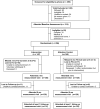Biophysiologic outcomes of the Enhancing Adherence in Type 2 Diabetes (ENHANCE) trial
- PMID: 22818724
- PMCID: PMC3436596
- DOI: 10.1016/j.jand.2012.05.008
Biophysiologic outcomes of the Enhancing Adherence in Type 2 Diabetes (ENHANCE) trial
Abstract
Background: Behavioral research to improve lifestyle in broadly defined populations of patients with type 2 diabetes is limited.
Objective: We evaluated a behavioral intervention featuring technology-based self-monitoring on biophysiologic outcomes of glycemic control and markers of cardiovascular risk.
Design: In this single-site, randomized clinical trial, participants were stratified by good and poor glycemic control (glycated hemoglobin <8% or ≥8%) and absence or presence of kidney disease, (estimated glomerular filtration rate ≥60 or <60 mL/min) and randomized within strata. Measurements were obtained at 0, 3, and 6 months.
Participants/setting: Self-referred, community-dwelling adults with type 2 diabetes mellitus.
Intervention: The intervention group received Social Cognitive Theory-based counseling paired with technology-based self-monitoring, and results were compared with an attention control group.
Main outcome measures: Glycated hemoglobin, fasting serum glucose, lipid levels, blood pressure, weight, body mass index, and waist circumference were evaluated.
Statistical analyses performed: Mean differences within and between randomization groups were compared over time. Intervention effects over time were estimated using random intercept models.
Results: Two hundred ninety-six subjects were randomized, 256 (86.5%) completed 3-month and 246 (83.1%) completed 6-month assessments. Glycated hemoglobin was reduced in the intervention group by 0.5% at 3 months and 0.6% at 6 months (P<0.001 for each), and the control group by 0.3% (P<0.001) at 3 months and 0.2% (P<0.05) at 6 months; but between-group differences were not significant. In those with baseline glycated hemoglobin ≥8% and estimated glomerular filtration rate ≥60 mL/min, glycated hemoglobin was reduced in the intervention group by 1.5% at 3 months and 1.8% at 6 months (P<0.001 for each), and the control group by 0.9% (P<0.001) at 3 months and 0.8% (P<0.05) at 6 months; but between-group differences were not significant. In random intercept models, the estimated reduction in glycated hemoglobin of 0.29% was not significant.
Conclusions: Two behavioral approaches to improving general lifestyle management in individuals with type 2 diabetes mellitus were effective in improving glycemic control, but no significant between-group differences were observed.
Trial registration: ClinicalTrials.gov NCT00222846.
Copyright © 2012 Academy of Nutrition and Dietetics. Published by Elsevier Inc. All rights reserved.
Figures
References
-
- Centers for Disease Control and Prevention . National diabetes fact sheet: national estimates and general information on diabetes and prediabetes in the United States, 2011. U.S. Department of Health and Human Services, Centers for Disease Control and Prevention; Atlanta, GA: 2011.
-
- United States Renal Data System . USRDS 2009 Annual Data Report: Atlas of Chronic Kidney Disease and End-Stage Renal Disease in the United States. National Institutes of Health, National Institute of Diabetes and Digestive and Kidney Diseases; Bethesda: 2009.


